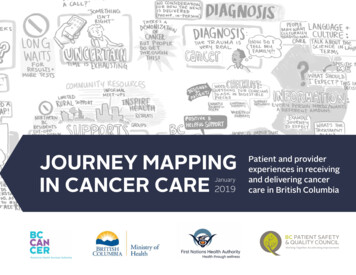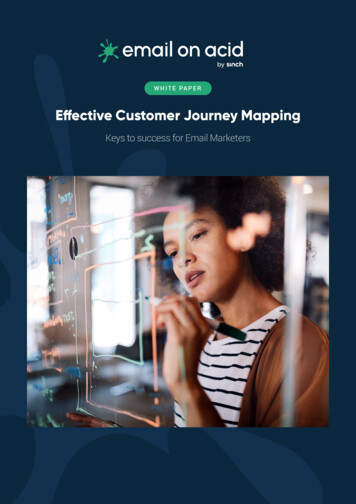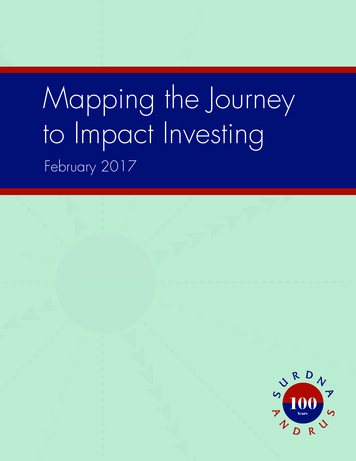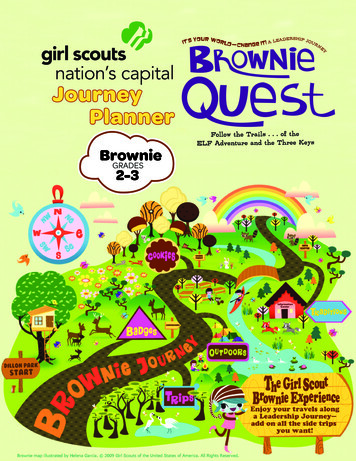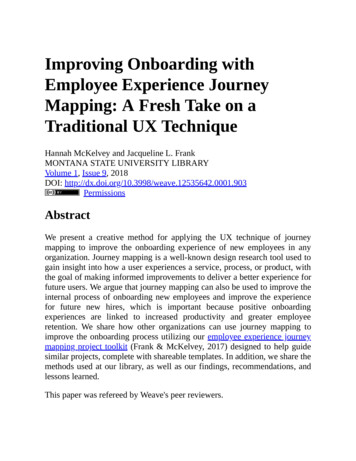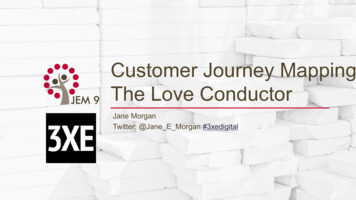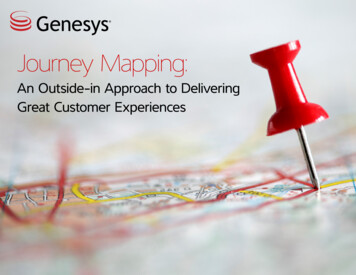
Transcription
A Genesys eBookJourney Mapping:An Outside-in Approachto Delivering GreatCustomer Experiences
1. What’s a customer journey?A customer journey is the set of interactions a customer has with your business to complete a task suchas evaluating, onboarding, getting support, or renewing a product or service.Taking a step back, Customer Journey Management is an omnichannel customer engagement strategythat takes an outside-in approach from the customer’s perspective to improve customer experience(CX) for the most important of your customer’s journeys. It’s a subset of Customer ExperienceManagement (CEM) which Gartner defines as “the practice of designing and reacting to customerinteractions to meet or exceed customer expectations and, thus, increase customer satisfaction, loyaltyand advocacy.”In practice, Journey Management typically involves breaking down traditional system, departmentand channel silos to unify and automate the customer engagement process. Cross-channel customercontext is collected and analyzed to inform self-service and assisted service next best actions in realtime and then to support continuous optimization of the customer experience over time.In each industry, only the subset of journeys that drive high transaction costs or high incrementalcustomer value (CX, loyalty, up-sell) really matter. These are where we focus efforts for thegreatest returns.genesys.com2
Companies that focus on journey optimizationperform dramatically betterWebsiteMobile AppContact CenterBack OfficeBranchPurchase JourneyOnboarding JourneyAccount Change JourneyProblem Resolution JourneyRenewal and Repurchase JourneyRevenueGrowth 10 to15%CustomerSatisfaction20%Lower Cost toServe15 to 20%* Source: McKinseygenesys.com3
2. W hy focus on customer journeysto get outside-in?Customers are increasingly empowered bycompetition, digital channels and easy accessto information, forcing businesses to reinventthemselves to increase customer value anddeliver great experiences.As customers and their devices become moreintegrated and connected to your business andsystems via the Web, self-service and mobileapps, you typically need to re-factor systems andprocesses to consistently support customers onthese new touchpoints. This digital disruptionis making customer experience a priority andshifting business focus from traditional systemsof record to dynamic systems of engagement.Taking a journey-focused, outside-in approachto continuous CX optimization helps put thecustomer at the center of your business strategy,which in turn drives loyalty and revenue.Companies with a mature approach to customerexperience take an iterative, disciplined approachto continuous improvement, with the ongoingassessment and optimization of customerjourneys as a core practice.genesys.com4
3. What are journey maps?The traditional focus of IT systems primarily accounts for theinformation under the company’s control, but the customer’sbuying cycle starts long before they visit the website — and theservice and support experience continues long after they placetheir order. Companies that fail to take the full buying cycle intoaccount commonly under-deliver on customer expectations.EVALUATEPURCHASESUPPORTSo how do you visualize the outside-in scenario to see thefull picture including customer perceptions, mobile and socialmedia engagement? The short answer is by creating journeymaps which visually document a customer persona’s needs,perceptions and the touchpoints encountered for each steptowards the customer’s journey goal.Journey maps are a common approach used to designcustomer-centric processes for multi-channel customerengagement. They often serve as the foundation for CXoptimization programs, identifying new ways to help yourcustomers reach their goals while still delivering on thecompany’s objectives. As one of the primary discovery toolsemployed to better understand your customer’s interactions withyour company, these journey maps should be data driven andsourced both from customers and direct research (e.g. mysteryshopping, customer interviews, observation, web analytics). Theultimate purpose of the exercise is to find flaws, weaknesses andopportunities for improvement in the current process.genesys.comJourney maps are like snowflakes no two journey maps will be the same.5
4. H ow do journey maps improvecustomer experience?Different parts of the organization such asmarketing, sales, support and collections oftenonly understand their portion of the user’s endto-end journey. They naturally gravitate towardssupporting their own touchpoints, which thencreates organizational silos. For example, it’s notuncommon to find multiple departments sendingexcessive and overlapping communicationsto customers.Journey maps serve as a corrective lens, providingan outside-in perspective and helping multipleteams within the organization understand thebig picture from the customer’s perspective andcreate a shared understanding of the experience.They create alignment across your business andhelp drive customer-centric change from productteams and business unit leads to IT operationsand then out to marketing, sales and service.These groups are usually hindered by poorexchange of information, bad assumptions, lackof common standards and duplication of effort.genesys.com6
4. H ow do journey maps improvecustomer experience?Journey mapping helps your organization better understand the customerexperience including all the journey steps and touchpoints along the way toachieving their goals. By exposing the gaps between the user’s expectationsand perceptions at key steps in the journey, they inform the ecosystem(applications, touchpoints, devices), participants (partners), process stepsand influencers (social media) that enable the customer journey. There istypically a complex set of relationships at play.Journey Maps are instrumental in identifying latent user needs and pain.Correctly applied, they: Surface customer-centric insights into back-office and customer-facingsystems that inform opportunities and drive business value, Deliver the context needed to support solution ideation and the validation,prioritization, design and testing of solutions for each idea, and Inform where to apply more effort, personalization, consistency orproactive communication to improve the customer experience.genesys.com7
5. Where to start?Which journeys matter?Show do you identify the right areas to focus on to be strategic vs.opportunistic when deciding which customer journeys to map? Somejourneys will be obvious to everyone as there are known problems andexecutive buy-in is easy, but you need to take a step back to identify whichjourneys really are most important and to ensure your efforts are alignedwith long-term, strategic planning.As a change management tool that brings a customer perspective tooperations, journey maps can support a wide range of strategic and tacticalobjectives from transforming multi-channel experiences to identifying andresolving specific customer pain points. Rather than just starting with thelow-hanging fruit, you need to illuminate the big picture to set the foundationfor a broader perspective. This working framework then serves to align theteam, standardize terminology and inform the effort and benefits to driveprioritization.You can next start to apply prioritization criteria andreview early metrics to identify which journeys mattermost to your customers and present the greatestopportunity to reduce pain and create delight. Whenevaluating where to start, work to factor in the goals ofyour organization as well as cost, revenue, retention,brand reinforcement, customer satisfaction or otherKPI-based benefit drivers as weighted selectioncriteria. Creating a weighted matrix for prioritizationhas the additional benefit of providing transparencyand alignment across the organization to focus oncommon goals. Scoring opportunities by effort andvalue is measure results and drive insights forimprovement via closed loop optimization.genesys.com11
1. Collect2. Engage3. OptimizeIdentify customer andinteractions across channelsAnalyze in real time to understandcustomer behavior, intent, engagementprofile, opportunities, etc.Drive Personalized and Proactive Engagementbased on Customer Context, Business Rulesand Predictive Next Best ActionsWebsiteActionable Insights & NextBest Action OfficeRouting &OrchestrationInboundCustomer Engagement onBack Office SystemsOutbound Communicationgenesys.com12
8. A pplying journey mappingto your organizationGenesys can conduct a detailed discovery of your requirements using theGenesys Wow Method. This new way of assessing Customer Experiencevisualizes the current customer journeys and identifies the root causeof current pain points. As the Customer Experience leader with morethan 10,000 customers, Genesys brings tested and proven CX Designmethodologies to the table.High level examples of journey optimization applied include: Tiered Service – Offer different routing strategies and service levels basedon segmentation, projected lifetime value, profitability, current satisfaction,churn risk or other factors. This maximizes value for the customer and thecompany (matching the expense to the reward). Omnichannel Context – Know when a customer is active on anotherchannel and leveraging that context. Interceptors – Optimize handling for frequent contacts to get to previousagent or best agent. Personalization – Personalize service via a customer profile to reduceeffort on repeat transactions or target recommended offers. Effort Tracking – Track customer effort in real time and escalate to improve CX. Proactive Communication – Add proactive notifications to keepcustomers informed.genesys.com13
Take your customer experienceto the next levelOrchestrate seamless, omnichannel customer journeys from a single, allin-one, customer experience platform. Available both on-premise and in thecloud, the Genesys Customer Experience Platform simplifies administration,increases operational performance, and reduces total cost of ownership.Get startedRequest a demoContact usgenesys.com14
Genesys powers more than 25 billion of the world’s best customer experienceseach year. Our success comes from connecting employee and customerconversations on any channel, every day. Over 10,000 companies in more than100 countries trust our #1 customer experience platform to drive great businessoutcomes. Genesys on-premise and cloud solutions are built to be fluid, instinctiveand profoundly empowering. Combining the best of technology and human ingenuity,we work the way you think.Connect with Genesys via genesys.com, social media, and the Genesys blog.Contact us at 1.888.GENESYSor online atgenesys.comCopyright 2017 Genesys. All Rights reserved. Genesys and the Genesys logo are registered trademarks ofGenesys. All other company names and logos may be registeredtrademarks or trademarks of their respective companies.
identification to build the customer journey map. Additionally, stakeholder maps and interviews are conducted to gather the organization's perspective on CX. The cross-functional design team drives the customer journey mapping exercises to discover latent user needs and define solutions from the perspective of the targeted user. The research .

